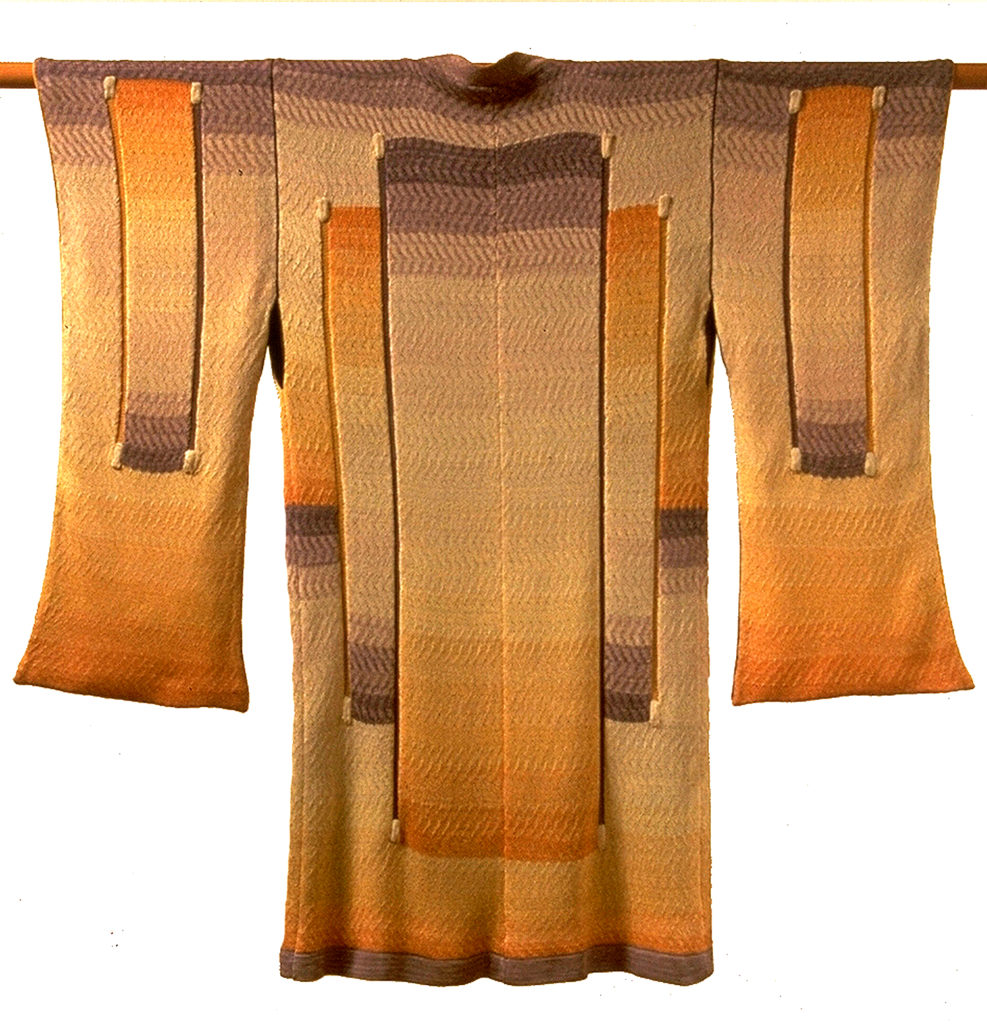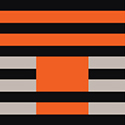by Rebekah Younger

Long before I learned to meditate, I was an avid knitter—so much so that my mentor suggested using my knitting for artistic expression. He observed that a large unfinished painting remained on my easel for years, yet I spent hours knitting compulsively. While I eventually finished the painting, I took his suggestion. I started designing knit garments to exhibit in wearable art shows. For the next twenty-five-plus years I worked as a fiber artist, creating and selling thousands of garments showcased in museum exhibits, craft shows and on magazine covers.
What did I find so compelling about knitting? I was relaxed in the present, without concern for the past or the future; I was on the dot. The feel of the fiber, the repetitive motion of the needles, and the richness of the colors connected me to my physical sensations. I was totally absorbed in the activity, without doubt or hesitation, because my mind and body were in synch.
The soothing repetitive motion lulled me into a contemplative state or kept me closely focused depending on the pattern I was knitting. I might drift into a reverie, moving to the steady rhythm of a ribbing or garter stitch. Slowly turning a length of yarn into a garment, my hours of effort were measured in inches of knitting. Only later did I realize this was a form of mindfulness meditation in action. When I began machine knitting to produce my garments for sale, there was still handwork to do mindfully.
A pivotal moment in my work began at dusk on a California beach in Point Reyes National Park. The entire sky was a smooth transition of luminous color, from dusty salmon to deep lavender, reflected in the receding tidewaters below. I experienced such tranquility and joy viewing the rich hues magically melting into each other! I photographed the fading afterglow, longing to stay there forever.
I wanted to create a knit garment to express the beauty of that sunset. How could I recreate this subtle gradation in my clothing? I was frustrated with early attempts using commercially dyed colors that I changed every few rows. This created stripes no matter how many shades of color I used. I wanted the colors to blend seamlessly like the evening sky.
After knitting several striped sweaters, I decided to try again, designing a knit kimono for an art to wear exhibit. I hired a fellow fiber artist to dye fine silk yarn in seventeen sunset hues. I chose to break up the stripes with a vertical pattern using two closely related shades in each row to reduce the impact of the stripes. I would change one color at a time, every few rows, which did make the stripes less noticeable but still visible.
The design included inset rectangles of reversed color gradations to suggest the reflected afterglow in the wet sand. Juxtaposing the contrasting gradients created an excitingly unpredictable placement of color combinations in the finished garment. Having complementary colors, such as lavender and golden yellow, side by side caused the colors to really pop.
I loved the contrasting gradients, yet the kimono took more than 100 hours to complete because of all the color changes. This was definitely a one-of-a-kind garment! There had to be a faster way to create a smooth gradation of color. Then came the “aha!” moment.
Machine knitting plain panels of fabric can be done in minutes, unlike hand knitting. I would do what was unthinkable in hand knitting. I would knit two separate panels, hand dye each with an even gradation of color, then unravel them and knit them in a two-color pattern in one garment. There would be two lengths of yarn with a smooth gradation of color. For example, I might dye one panel blue to violet and the other red to yellow. The two lengths of unraveled yarn would then be knit in a pattern starting with blue next to the red gradually transitioning to violet and yellow. My process had moved beyond recreating the sunset to working with the unpredictability of combining two color gradients in one knit pattern.
I started innovating techniques to accomplish my vision, learning how to dye knit silk and creating formulas to calculate the knit yardage needed for dyeing. Then I designed sweaters featuring the dyed patterns that could be produced affordably. The sunset inspiration morphed into an endless array of creative possibilities.
Gradient-dyed knits became my signature look as a fiber artist, and I sold hundreds of sweaters featuring dye techniques I developed. I wrote an article for Threads magazine describing my knit-dye-unravel-knit process. Now knitters can buy pre-knit panels to dye in their own color gradations. All this came from that one evening on the beach. Creating is like that. You never know where a creative spark will lead. It starts from a single moment of being open and awake, followed by hours of activity to express your inspiration.
I prefer the word “creating” rather than “creativity,” because it is a verb, indicating activity, rather than something someone has as a talent or learned trait. Creating is as simple as placing a flower in a vase or as complex as making a movie. If we remain open to our experience, we all have the ability to create. We create our lives with the actions we take. We create community with the people we choose as friends and how we relate to family. We might create our home, events, or even a business. Not all creating is art and not all creators are artists.
Whether we consider ourselves artists or not, we have the capacity to create through our choices and actions. We are translating our experience into an expression whenever we tell a story, take a picture, or make a gesture. By first connecting to our being and awakening to our experiences, the expression is genuine to the moment. Each choice and action we take impacts what we create. Whether the act is spontaneous, intuitive, or deliberate, creating brings inspiration into form. If you think something, it’s simply an idea. Once it is expressed it becomes something more tangible, something to relate to. For it to become a creation, action is required. You are giving birth to an outcome, whether it is art or a life.
Adapted from Be, Awake, Create: Mindful Practices to Spark Creativity
by Rebekah Younger ©2019 – Reveal Press

2 thoughts on “Unraveling Creativity”
Excellent! Thank you!
Thanks, Jennifer! I am just now seeing your comment.